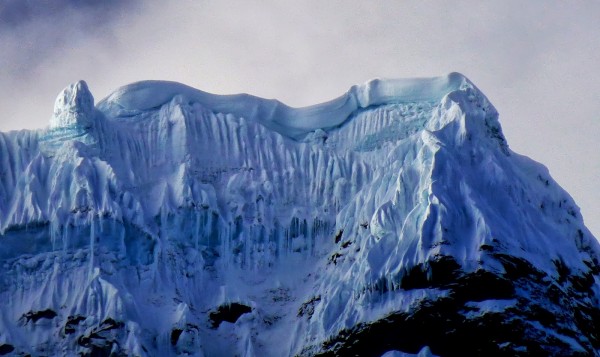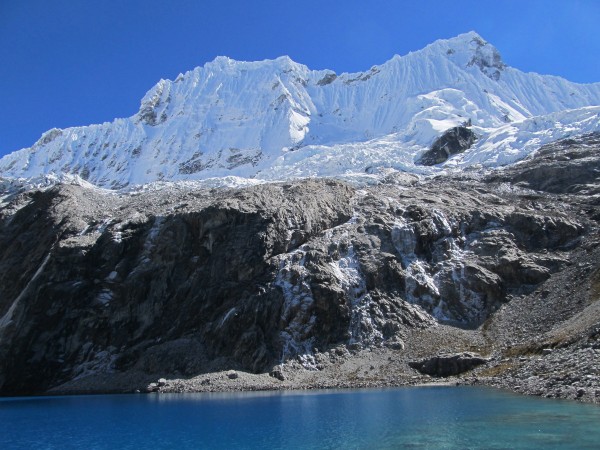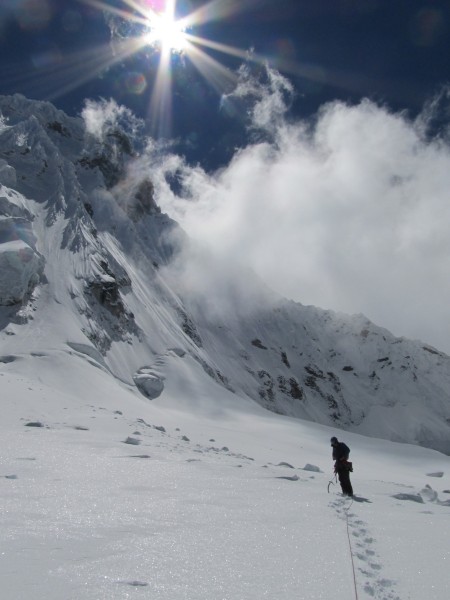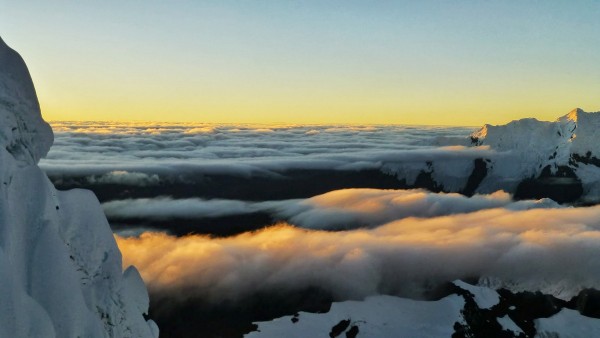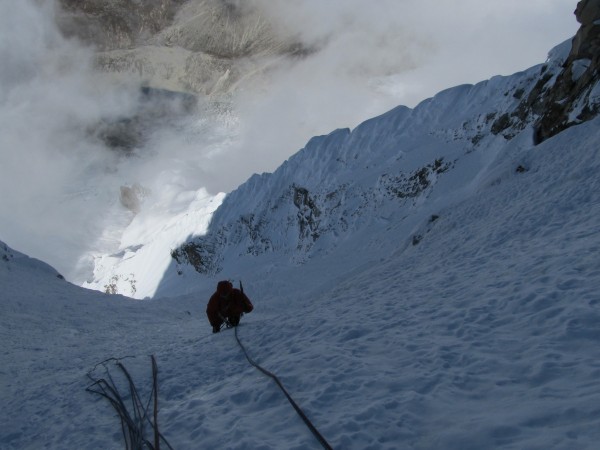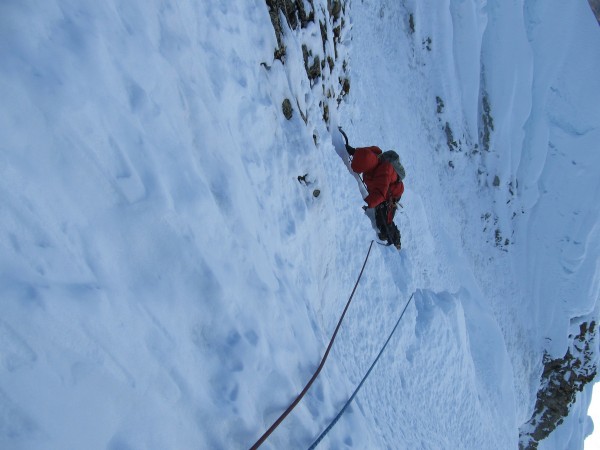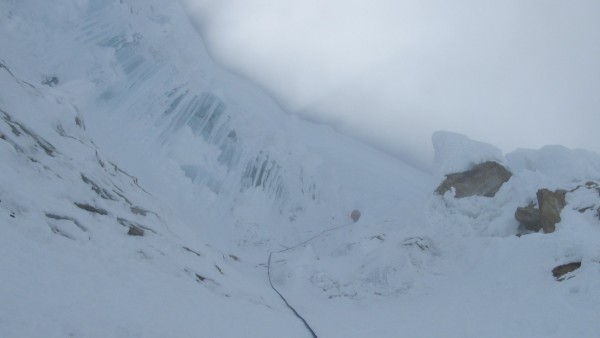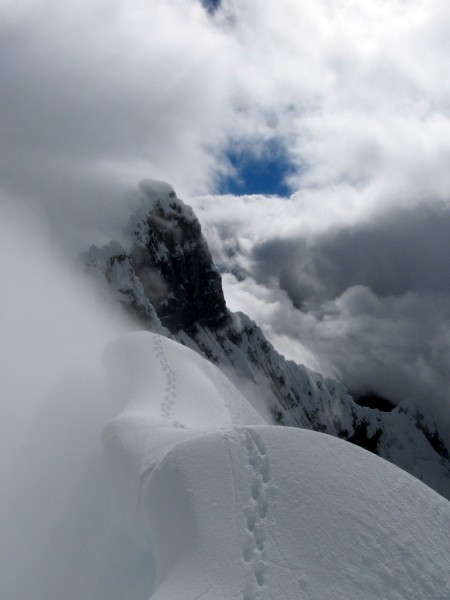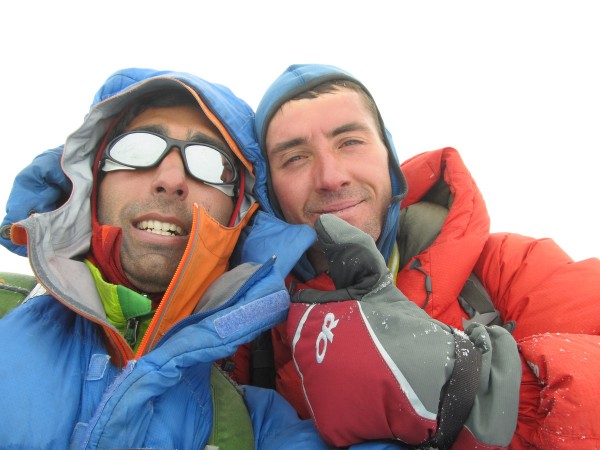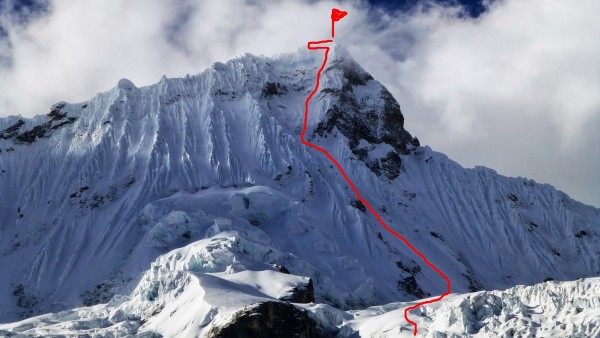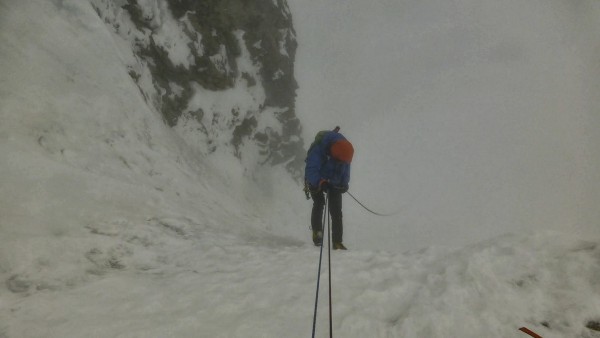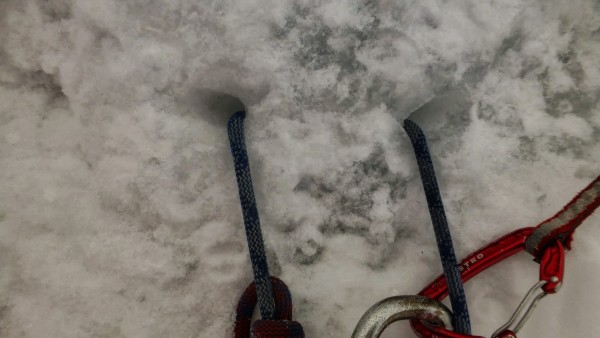I'm not sure about other climbers, but when I walk into the mountains I do it to see beauty, to laugh with the people who join me, and for the simple joys of touching rock, whacking ice, or running down talus. I do it so I can walk in windstorms and feel snow stinging my face, to hear the buzz of silence when the wind is gone, to walk at night under a moon so bright that I don't need any other light. I don't do it to prove that by cleverness, strength, or luck I can stand atop dangerous summits. When I imagine scrambling along ridges in the Sierra Nevada on warm summer days, I smile. I remember joy. When I remember the summit of Chacraraju, the swirling clouds, the shivering, the rappel from a single snow picket tenuously buried near the lip of a fickle cornice---I can't say the same. I remember vividly the place. I remember fear. I remember resignation to the invisible forces of chance buffeting us back and forth. But I do not remember joy.
At camp we decided to climb Chacraraju Este (6001m, Peru) by the Jaeger Route. We'd initially wanted to climb the French Direct on the west peak, but it looked too dangerous; the Jaeger Route was a good compromise that balanced my fear, my desire to climb, and my obligation to be a good partner. The route is slightly shorter than the French Direct and slightly easier at ED1 instead of ED2, but it rarely sees ascents to the summit because of a notoriously unstable cornice; the well-known British alpinist Nick Bullock wrote, “the summit [of Chacraraju Este] was not climbed to, as life appeared more favourable.” A pair of climbers heard we'd reached the summit and attempted the peak a week later, and I'm so sorry to write that one of them died on the descent when the cornice collapsed. We were lucky, they were not.
We left Huaraz on July 21, 2013, for the Chacrarajus. Like usual we carried our 30kg packs without donkeys, but unusually for us we took a tourist van because the laguna is a popular tourist destination and we had the option. We arrived at the trailhead just as bad weather blew through, and as it would turn out we would finish our climb just as more bad weather came in. We reached the laguna in the afternoon and slept. The next morning we started late, packed camp, and moved up some recently-exposed, loose talus to the toe of the glacier under Chacraraju Oeste. I bailed. As we descended I considered moving my return flight up to get back to my familiar and safe Sierra Nevada; a few hours later I was planning to ascend the east peak.
Three Chileans joined us at camp that night and told us they were also going to climb the Jaeger Route. Their plan was to move camp the next day onto the glacier near the bergshrund, which is 800m above the lake. Tired of our heavy packs we decided to gamble on our fitness and acclimatization by keeping camp at the lake and doing the approach and climb in a single push. We did however spend a day breaking trail to the bergshrund because recent storms had made glacier travel slow.
How slow, however, I hadn't imagined. At times I felt it would be more accurate to say I swam the approach instead of walked it. It took us three hours to ascend what took us twenty minutes to descend. We got back to camp in early afternoon after stashing our gear high in a moraine near the glacier. I ate a half kilo of salami and passed out early for our midnight alarm. I had fitful sleep but felt strong when I woke up, and we made it to our gear cache over 500m above camp in an hour. Crampons and harnesses on, we were at the bergshrund by 3 am and simul-climbing the endless fifty-five degree snow and ice at the bottom of the Jaeger Route. We finished the bottom three-quarters of the route by early morning. When dawn finally broke the views of the Huandoys, Chopicalqui, Huascaran, and the clouds spilling in from the Amazon were stunning.
At the three-quarter mark we started to pitch everything out. The angle ramped up and there were vertical steps of hollow, unprotected ice; screws would bite and dig in for an inch but spin uselessly in air pockets beneath. We swapped leads through this part as the floor of clouds climbed higher and eventually engulfed us. Vitaliy led past toothy icicles and set our third-to-last belay---our last safe one---in a runnel 10m below the formidable summit cornice. It was around 11 am. I climbed past the belay in a claustrophobic snow runnel with my back pressed against the right wall, my feet on the left wall, and my axes buried deep in powder snow in the back. When the runnel ended I found myself under the summit cornice, which was 6m thick above and severely overhung. I could only go right or left. Right looked hard so I chose to go left to a spot where the cornice was thinner; I would try to tunnel through to get on the summit ridge.
As I traversed left I had to cross the famous Andean flutings. These are thin, delicate ridges that separate snow runnels and can collapse at the slightest touch. With axes in last season's barely consolidated snow in the belly of the cornice I inched left with boots planted only in hope. As fluting after fluting collapsed and drained into the couloir below I prayed I would find some solid ice to take a screw.
When I arrived at the thin part of the cornice I found that it was so overhung that I couldn't stand straight to dig. I planted my left pick upside-down in the firm snow under the cornice and leaned back to dig with the other. My forearm burned and I had to shake out countless times as I dug. An hour later I had a vertical tunnel through the cornice but it was impossible to climb---the snow disintegrated around my picks and hands. I couldn't make a belay where I was, and even if I did we couldn't bail from there. The terrain below was overhung and unlikely to yield good rappel anchors. I couldn't reverse some of my moves to Vitaliy's anchor without risking a fall on marginal gear, either. The safest bet was to get on the ridge and rappel the way we came.
I tried to aid through the tunnel I'd dug by planting snow pickets, attaching girth-hitched slings, and stepping gingerly up with cramponed feet. I planted one picket in the low, firm snow at a slightly upward angle. The next wasn't quite as good because it was in the higher, looser snow, and as I clipped in and lightly bounce-tested it blew. Before I understood what had happened I was suspended from my right foot, hanging in midair under the cornice from crampons snagged in my lower aider. Vitaliy never felt a tug; my weight was fully on my foot above my head on a picket that had miraculously withstood a shock load. I started to hyperventilate when I realized that a picket---the lowest form of climbing protection, the least likely to ever work---had kept me from ripping out the token piece I'd placed before it and from falling on the anchor. I had to calm myself, still upside down, to regain control.
My makeshift aider was tangled around my crampons and I had to get right-side-up with gravity and jangling ice screws, three-foot pickets, and five layers of clothing fighting against me. I tried several times to do a sit up and stand again in my aider, but with the weight of my gear and the thinness of the air at 6000m it was impossible. I fell each time, defeated, back into my hang. In desperation I decided to pull the lower part of the rope to get some of my weight off my foot then to pry my crampon points one-by-one from the twisted mess of my aiders. With the last point freed I knew I would fall. I held the rope, planted an axe, and prayed again as it shot out.
After getting back into the normal climbing position and letting my heart rate settle, I realized that I was soaked---literally dripping water---from a combination of digging through Andean powder and the white out mist around us. It was 2 pm and I'd spent three hours on this lead. I really needed to finish; I was starting to shiver despite having five layers on my torso. I half-heartedly tried to dig another hole where the cornice was less overhung, but it was just too strenuous from the undercling and would take hours. However I noticed that the cornice appeared to end at a notch in the summit ridge 15m to my left; I had not tried to traverse there because the terrain looked more dangerous than the traverse I'd already done. But without options---reversal impossible, my tunnel useless---I stepped left into impossible-looking flutings under the most villainous, forbidding part of the cornice.
As I traversed left I moved farther and farther from the security of the picket that caught my fall. Several meters from the notch and ten from the picket I found myself hanging from two pick placements in a rare patch of good ice, but with my crampons scratching at empty air. Desperate to finish I put enormous faith in my left tool, matched, released the right tool, and placed it farther left. I campused twice more to gain a ramp to the notch. With a meter of rope left I peeked over the notch to the Paron Valley. If we weren't engulfed in a white out I'd have been able to see Caraz and La Esfinge. All I saw was that the cornice looked surmountable from the notch. I downclimbed to a stance, buried a picket in sugar snow, and settled into a long belay. It was 2:30 pm and my lead had taken nearly four hours. I was careful not to move my legs because every time they touched my soaking pants I shivered.
When Vitaliy reached the cornice tunnel and realized I'd done the 15m traverse to the notch, he decided to finish the tunnel job. I did not want to repeat the traverse to follow the tunnel to the summit, but I didn't say anything as he tried to aid the tunnel. I knew the snow above the first placement was impossible to aid with our pickets. He has to fail at it himself, I thought. I can't tell someone to repeat that traverse. Although the patch of blue ice that had harbored my tools contained a screw, it was ultimately just a patch of ice attached to a cornice, and if Vitaliy fell after removing the picket at the tunnel my token belay would blow and we'd both load the screw, and therefore the cornice, after falling into the overhanging terrain below. He eventually resigned himself to the traverse after a few sputtering efforts at the tunnel. As he climbed down from the tunnel and began the traverse he was uncharacteristically silent. At the tool-matching campus moves he faltered. In an appeal to our desperation and to his competitive spirit I reminded him that I did the traverse without knowing what was ahead. There are good sticks, I promised. He finished it and reached the belay.
When he arrived he asked me to lead the next pitch. I told him that I was shivering too much to stand on the summit ridge in the wind on belay; he would have to lead it. He set off to the notch and climbed onto the summit ridge at last. In four hours we'd moved up only 15m but were finally on the ridge instead of just below. When he reached the summit proper he whooped and I whooped back, unable to see each other through the mist. I followed, stepping carefully into his boot tracks to conserve every iota of energy. Out from under the shelter of the cornice the wind quickly sucked the warmth out from under my dripping clothes. Mist rolled over the cornice, following its contours and disappearing in the mass of white shrouding the valley containing our tent far below. Periodic clearings revealed more of the tortuous, mushroomed ridge winding away towards the west peak.
At the summit we dug a four-foot deep T slot for our rappel anchor---a single buried snow picket. The rappel from the summit would require sliding over the thickest part of the cornice and would be free-hanging for nearly ten meters, so the anchor needed to be strong. Back in high school a friend and I used to make decisions on where to eat and what to do with rock-paper-scissors. With the prospect of putting all of our weight on a single picket Vitaliy and I opted to repeat this game to see who would go down first. Vitaliy lost, and as I watched him slide towards the lip of the cornice the west peak appeared through the mist. Unable to watch him weight the rope I turned my eyes and camera towards the west peak. It was crowned with clouds, and soon it was invisible again. When I looked down Vitaliy was gone but the rope was still there.
What followed were thirteen rappels, all on V-threads except two more snow picket anchors. We threaded our 8mm ropes directly through the V-thread holes so we didn't leave anything except pickets on the mountain. I used a good old-fashioned coat hanger-like candela to make the holes. By the third or fourth rappel I would consistently finish the holes by the time Vitaliy arrived at the anchor so we flew down the raps. Good thing---I'd expected that we'd be hard-up on anchors and would have to slowly downclimb the lower route. As we descended it started to snow and the spindrift slides around us grew.
We stopped rappelling 100m above the bergshrund and downclimbed easy snow until we were at the crack. We saw the Chileans' headlamps farther down the glacier and decided to stop to say hi and wish them luck, though I was skeptical anyone would climb in the whiteout and snow. They fed us some condensed milk and gave us water, which was welcome as we'd greedily dumped our water on the third-to-last pitch under delusions of finishing quickly.
The plod back to camp at Laguna 69 was slow and treacherous, since the recently-exposed talus was covered in snow. We arrived back at camp at 10 pm twenty-two hours after leaving. I ate some ramen, drank some hot chocolate, and passed out. The tent was soaked from the snow and rain, but I didn't notice; my hot chocolate kept me warm until morning.
The next day was stormy, and as we hiked out I my 30kg pack straps kept cutting circulation to my arms and sending pins and needles into my hands. Remarkably some tourists still plodded up to the lake in the horrendous weather. At the trailhead we met a group of generous Austrian tourists who gave us a free lift to Yungay. Their private bus would stop every ten minutes for them to get out and take pictures, which was simultaneously endearing and frustrating as we were starving and had finished the last of our food that morning.
When we finally arrived at home in Huaraz I wished we'd been at the end of our trip instead of the middle. I felt like I'd experienced a lifetime of risk and fear in a single outing. I wanted to rest. To understand what I'd been through. To put my own involvement in climbing, at least in alpine climbing, into perspective. But it was the middle of the trip and I didn't know when the circumstances of my life would again bring me here with so much freedom. So I ate some cake, drank some tea, slept, and went back to the mountains.
